Renewable Aviation Fuel Market Size
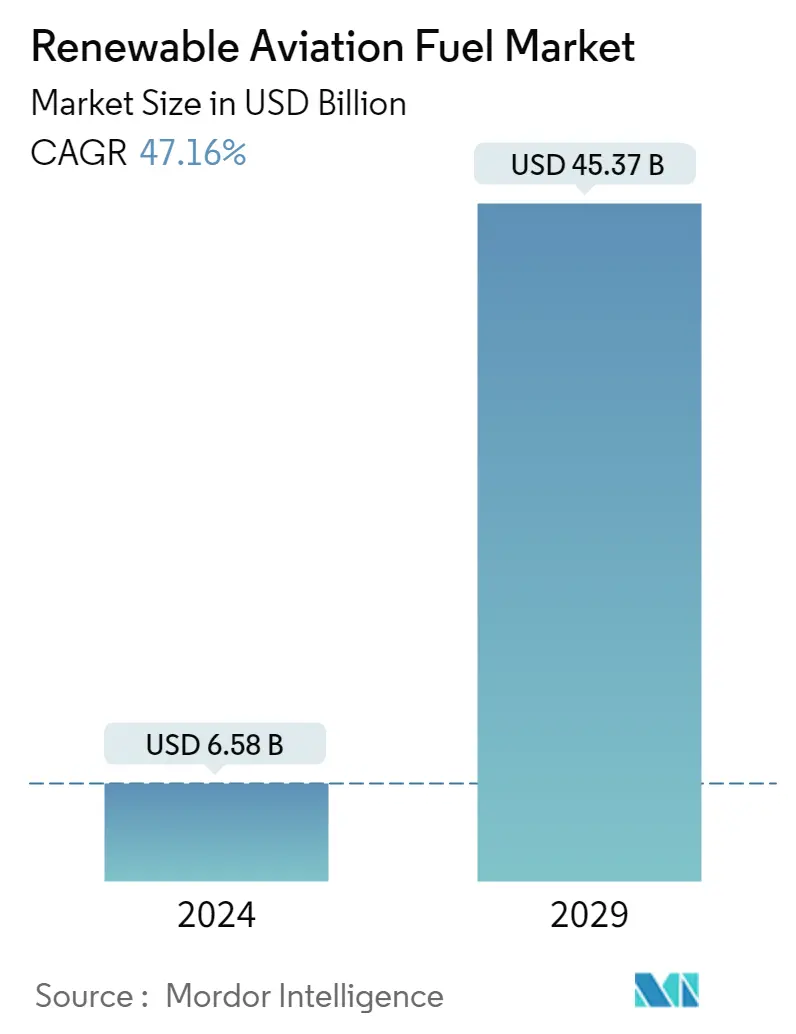
| Study Period | 2020 - 2029 |
| Market Size (2024) | USD 6.58 Billion |
| Market Size (2029) | USD 45.37 Billion |
| CAGR (2024 - 2029) | 47.16 % |
| Fastest Growing Market | North America |
| Largest Market | North America |
Major Players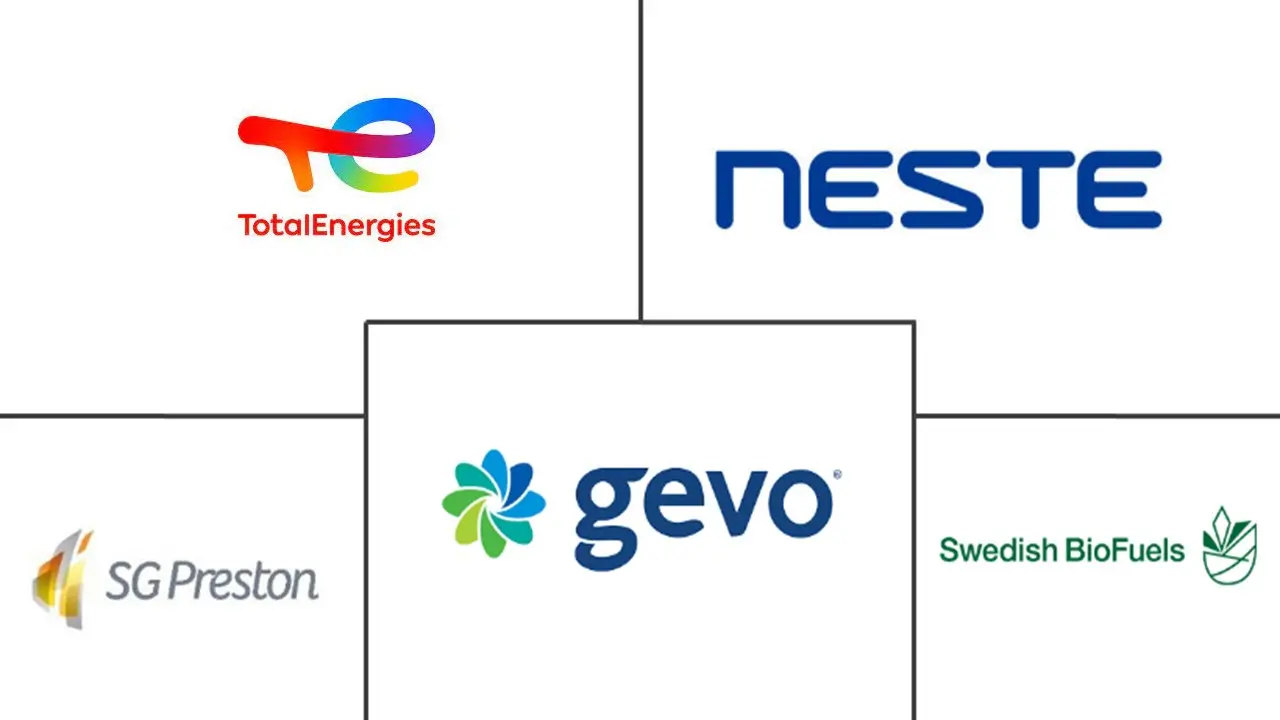
*Disclaimer: Major Players sorted in no particular order |
Renewable Aviation Fuel Market Analysis
The Renewable Aviation Fuel Market size is estimated at USD 6.58 billion in 2024, and is expected to reach USD 45.37 billion by 2029, growing at a CAGR of 47.16% during the forecast period (2024-2029).
The market was negatively impacted by COVID-19 in 2020. Presently the market has reached pre-pandemic levels.
- Over the long term, factors such as increased government regulations for greenhouse gas emissions, and encouraging production and consumption of renewable aviation fuel are likely to drive the renewable aviation fuel market during the forecast period.
- On the other hand, high costs of renewable aviation fuel are expected to restrain the growth of renewable aviation fuel market.
- Nevertheless, increasing demand from emerging regions like southeast asia are exoected to create lucrative opportunities for the renewable aviation fuel market in the forecat period.
- North America is likely to dominate the renewable aviation fuel market during the forecast period, with a majority of the demand coming from countries like the United States and Canada.
Renewable Aviation Fuel Market Trends
Hydroprocessed Esters and Fatty Acids (HEFA) Technology to Dominate the Market
- Hydroprocessed Esters and Fatty Acids (HEFA), commonly known as Hydrogenated Vegetable Oil (HVO) or Hydroprocessed Renewable Jet (HRJ), is a type of hydrocarbon aviation fuel made from animal or vegetable oils (triglycerides) by hydroprocessing.
- In 2011, hydro-processed esters and fatty acids (HEFA) technology received certification from the American Society for Testing and Materials (ASTM) for bio-jet fuel production. HEFA uses oleo-chemical feedstock, such as oil and fats, for renewable fuel production.
- A significant share of available commercial volumes of bio-jet fuels comes from HEFA biojet, with several commercial-scale facilities worldwide producing the same. However, renewable diesel (HEFA-diesel) is also made during the process, with a larger market scope and a higher sales price. Thus, producers are focusing on HEFA-diesel instead of HEFA-jet.
- Moreover, hydrocarbon aviation fuel made from animal or vegetable oils comes under bioenergy. According to International Renewable Energy Agency, in 2022, the total global bioenergy capacity accounted for 148 GW, expected to grow due to its environment-friendly nature.
- In January 2022, Johnson Matthey launched an innovative technology, HyCOgenTM, by converting captured carbon dioxide (CO2) and green hydrogen into sustainable aviation fuel (SAF) using FT technology. Such developments in the renewable aviation fuel sector will likely increase demand for FT technology during the forecast period.
- Furthermore, in December 2021, the UK Department for Transport announced support of GBP 15 million to Advanced Biofuel Solutions (ABSL), which was likely to work on a detailed engineering design for a new facility in Cheshire. The plant will be used for gasification and Fischer-Tropsch (FT) technology to convert an estimated 133,000 metric tons of waste a year into a biocrude that can be upgraded to aviation fuel. Thus, such investments in upcoming sustainable aviation fuel projects will likely increase the demand for FT technology during the forecast period.
- However, HEFA biojet fuel costs more than fossil-derived jet fuels, and the potential feedstock for the HEFA is also costly. To decarbonize the aviation sector, companies such as Boeing are testing the technical suitability of high freezing point HEFA (HEFA+) aviation fuel in aircraft. HEFA+ is a synthetic hydrocarbon from bio feedstock, such as vegetable oil or waste fats.
- Therefore, owing to the above points, the HEFA segment is expected to dominate the renewable aviation fuel market during the forecast period.
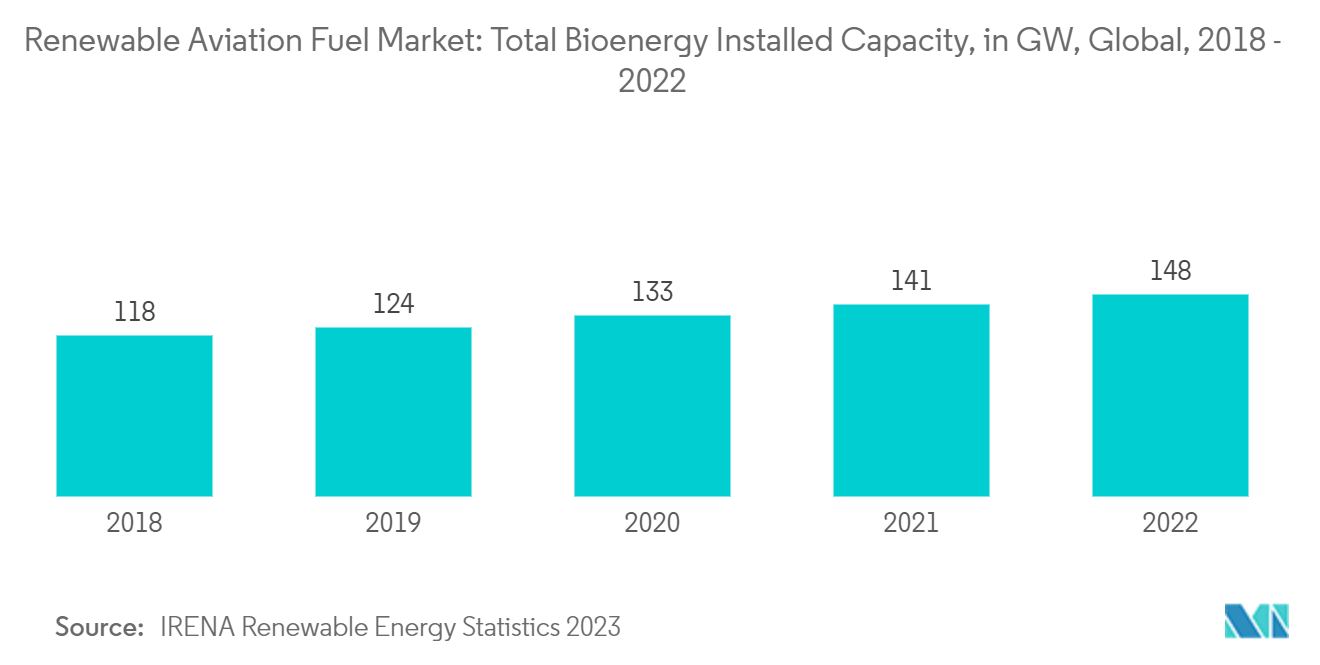
North America to Dominate the Market
- North America is one of the largest markets for the aviation industry and renewable aviation fuel. Between 1978 and 2022, US airlines improved fuel efficiency by over 130%, which resulted in nearly 5 billion metric tons of carbon dioxide savings. According to the Airlines for America (A4A), the country's airlines operate approximately 28,000 flights daily in the pre-pandemic stage. Most airline companies in North America posted heavy financial losses in 2020 and 2021. However, airline traffic is expected to recover during the forecast period. Further, as crude oil prices are increasing rapidly, the demand for renewable aviation fuel is expected to grow during the forecast period.
- The Bio-Energy Technologies Office (BETO) of the United States and the Department of Energy (DOE), supported by Energy Efficiency and Renewable Energy (EERE), are making efforts to expand the adoption of sustainable, domestically produced alternative fuels for transportation and aviation to stimulate the growth of the renewable fuel industry.
- In North America, the primary policy incentive for renewable aviation fuel production is the US Renewable Fuel Standard (RFS), which credits refiners and fuel importers who blend renewable fuel into transportation fuel to meet Renewable Volume Obligation standards.
- In January 2022, the Environmental Protection Agency (EPA) issued proposed volume requirements, under the RFS program, for cellulosic biofuel, advanced biofuel, and total renewable fuel. Under this proposal, the renewable fuel standard 2022 was set at 36 billion gallons, an increment of over 3 billion gallons over the previous year.
- Moreover, The Departments of Transportation, Energy, and Agriculture developed a road map to guide their efforts to boost this fuel supply. The White House issued a "Grand Challenge" to expand sustainable jet fuel production to 3 billion gallons per year by 2030 to reduce aviation greenhouse gas emissions. It aims to create enough fuel by 2050 to meet 100% commercial jet fuel consumption. In March 2023, the U.S. government revised thr goals by funding USD 34.5 million as an opportunity to improve the science and infrastructure for converting waste into biofuels and help support the 2050 goal.
- The existing framework of fuel policies in North America is expected to support hydro-processed esters and fatty acids (HEFA) fuel production in the future, thereby increasing the opportunities for HEFA fuel producers in the region.
- Therefore, such factors are expected to boost the dominance of North America in the market during the forecast period.
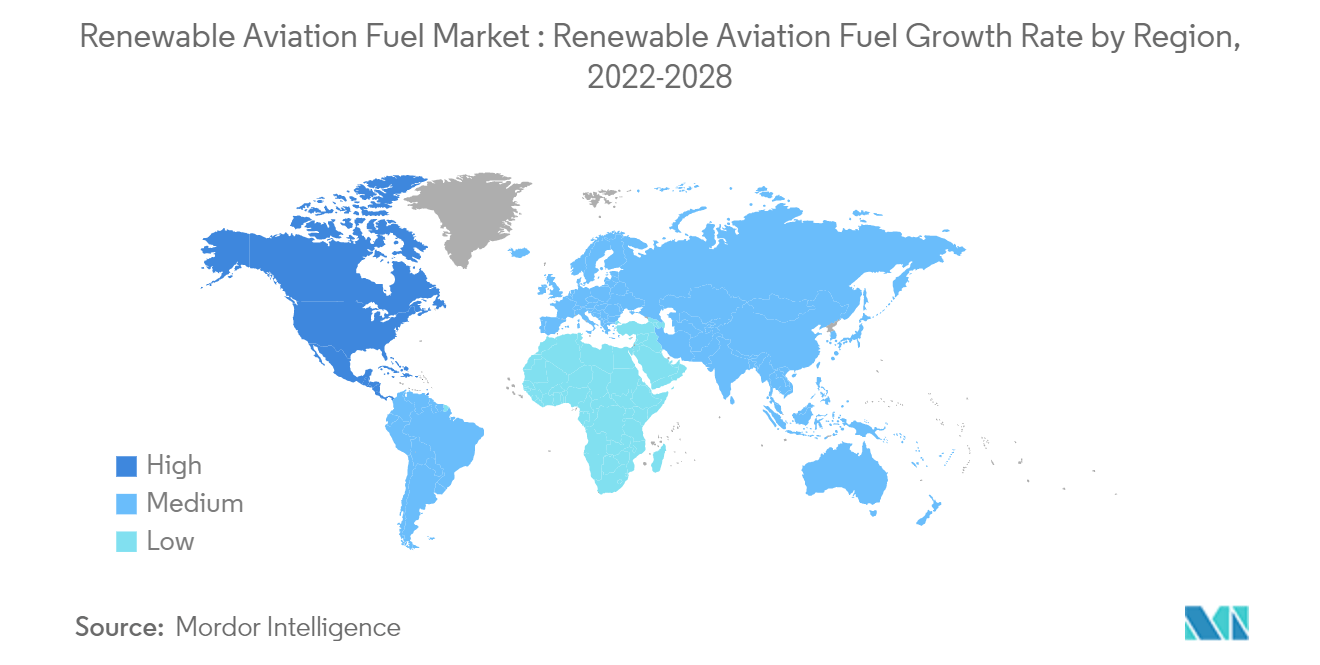
Renewable Aviation Fuel Industry Overview
The renewable aviation fuel market is moderately fragmented. Some of the major players in the market (in no particular order) include TotaEnergies SE, Neste Oyj, Swedish Biofuels AB, Gevo Inc., and SG Preston Company.
Renewable Aviation Fuel Market Leaders
-
Swedish Biofuels AB
-
TotalEnergies SE
-
Neste Oyj
-
SG Preston Company
-
Gevo Inc.
*Disclaimer: Major Players sorted in no particular order
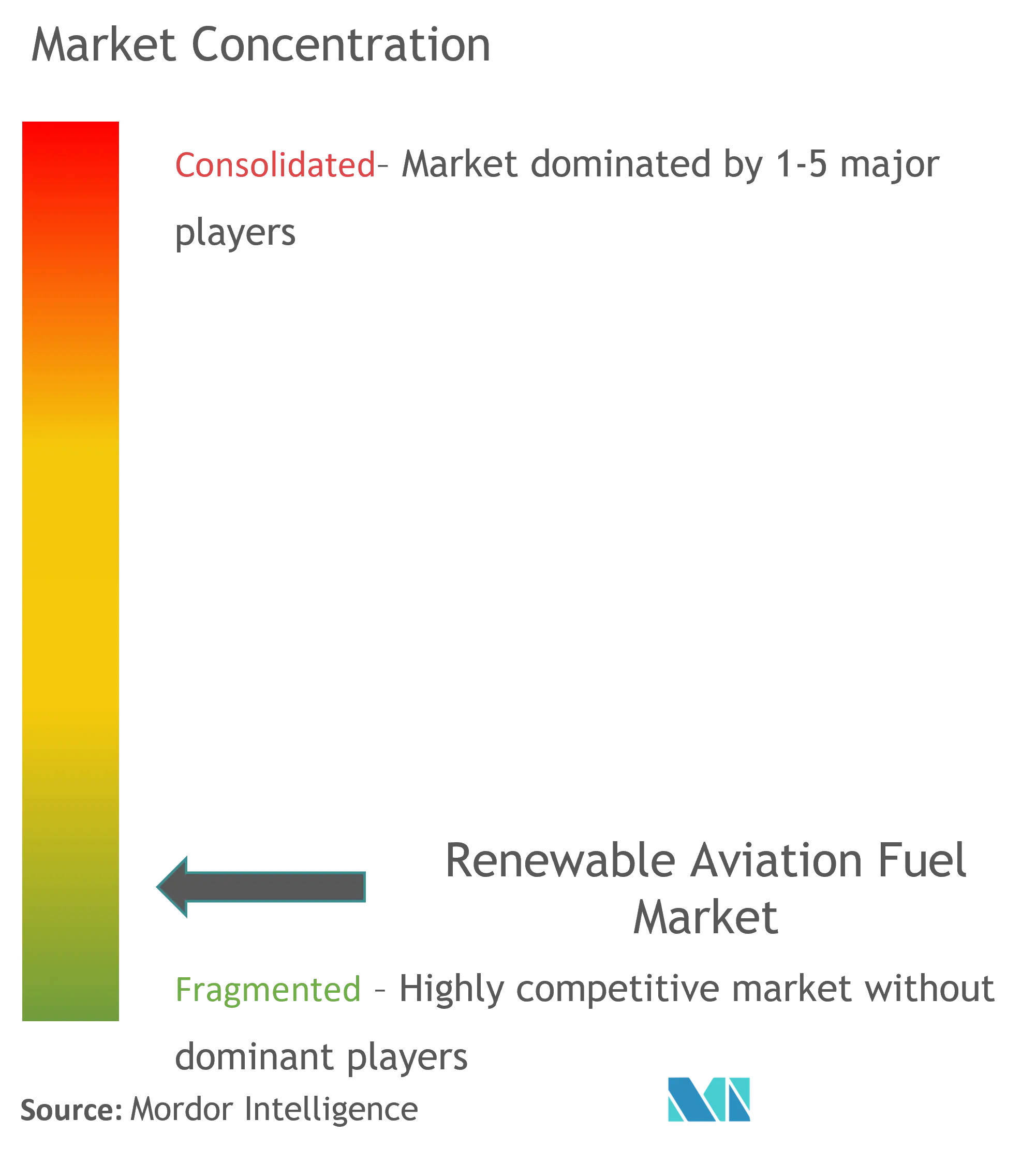
Renewable Aviation Fuel Market News
- In May 2023, Twelve and Etihad Airways, the national carrier of the United Arab Emirates, signed a Memorandum of Understanding (MOU) to collaborate on the advancement of E-Jet® fuel, Twelve's sustainable aviation fuel (SAF) made from CO2 and renewable energy, as well as plans for an international demonstration flight and a supply roadmap that will support Etihad's sustainability strategy.
- In February 2022, Engie SA and the US engineering company Infinium Holdings announced a EUR 500-million project to produce renewable aviation and maritime fuels in northern France. The final investment decision for the project is planned for the end of 2023, with commercial operations expected to start in 2026.
- In February 2022, Boeing announced a supply agreement for two million gallons of blended renewable aviation fuel with EPIC Fuels to power its commercial operations in Washington State and South Carolina by the end of 2022.
Renewable Aviation Fuel Market Report - Table of Contents
1. INTRODUCTION
- 1.1 Scope of the Study
- 1.2 Market Definition
- 1.3 Study Assumptions
2. RESEARCH METHODOLOGY
3. EXECUTIVE SUMMARY
4. MARKET OVERVIEW
- 4.1 Introduction
- 4.2 Market Size and Demand Forecast in USD million, till 2028
- 4.3 Government Policies and Regulations
- 4.4 Recent Trends and Developments
-
4.5 Market Dynamics
- 4.5.1 Drivers
- 4.5.1.1 Increased Government Regulations for Greenhouse Gas Emissions
- 4.5.1.2 Encouraging Production and Consumption of Renewable Aviation Fuel
- 4.5.2 Restraints
- 4.5.2.1 The High Costs of Renewable Aviation Fuel
- 4.6 Supply Chain Analysis
-
4.7 Porter's Five Forces Analysis
- 4.7.1 Bargaining Power of Suppliers
- 4.7.2 Bargaining Power of Consumers
- 4.7.3 Threat of New Entrants
- 4.7.4 Threat of Substitutes Products and Services
- 4.7.5 Intensity of Competitive Rivalry
5. MARKET SEGMENTATION
-
5.1 Technology
- 5.1.1 Fischer-Tropsch (FT)
- 5.1.2 Hydroprocessed Esters and Fatty Acids (HEFA)
- 5.1.3 Synthesisized Iso-Paraffinic (SIP) and Alcohol-to-Jet (AJT)
-
5.2 Application
- 5.2.1 Commercial
- 5.2.2 Defense
-
5.3 Geography
- 5.3.1 North America
- 5.3.1.1 United States of America
- 5.3.1.2 Canada
- 5.3.1.3 Rest of the North America
- 5.3.2 Asia-Pacific
- 5.3.2.1 China
- 5.3.2.2 India
- 5.3.2.3 Japan
- 5.3.2.4 Rest of the Asia-Pacific
- 5.3.3 Europe
- 5.3.3.1 United Kingdom
- 5.3.3.2 France
- 5.3.3.3 Germany
- 5.3.3.4 Rest of the Europe
- 5.3.4 South America
- 5.3.4.1 Brazil
- 5.3.4.2 Argentina
- 5.3.4.3 Rest of the South America
- 5.3.5 Middle-East and Africa
- 5.3.5.1 United Arab Emirates
- 5.3.5.2 Saudi Arabia
- 5.3.5.3 Qatar
- 5.3.5.4 Rest of the Middle-East and Africa
6. COMPETITIVE LANDSCAPE
- 6.1 Mergers and Acquisitions, Joint Ventures, Collaborations, and Agreements
- 6.2 Strategies Adopted by Leading Players
-
6.3 Company Profiles
- 6.3.1 TotalEnergies SE
- 6.3.2 Neste Oyj
- 6.3.3 Swedish Biofuels AB
- 6.3.4 Red Rock Biofuels LLC
- 6.3.5 Gevo Inc.
- 6.3.6 Honeywell International Inc.
- 6.3.7 Fulcrum BioEnergy Inc.
- 6.3.8 SG Preston Company
- 6.3.9 LanzaTech Inc.
- *List Not Exhaustive
7. MARKET OPPORTUNITIES AND FUTURE TRENDS
- 7.1 Increasing Demand from Emerging Regions like Southeast Asia
Renewable Aviation Fuel Industry Segmentation
Renewable aviation fuel (RAF), often considered sustainable aviation fuel (SAF), is a clean substitute for fossil jet fuels. SAF is produced from sustainable resources, such as waste oils from a biological origin, agriculture residues, or non-fossil CO2. The Renewable Aviation Fuel market is segmented by technology, application and geography. By technology, the market is segmented as Fischer-Tropsch (FT), Hydroprocessed Esters and Fatty Acids (HEFA), Synthesized Iso-Paraffinic (SIP) and Alcohol-to-Jet (AJT). By application, the market is semented into commercial. By geography, the market is segmented as North America, Europe, Asia-Pacific, South America, and Middle East & Africa. For each segment, the market sizing and forecasts have been done based on revenue (in USD million).
| Technology | Fischer-Tropsch (FT) | |
| Hydroprocessed Esters and Fatty Acids (HEFA) | ||
| Synthesisized Iso-Paraffinic (SIP) and Alcohol-to-Jet (AJT) | ||
| Application | Commercial | |
| Defense | ||
| Geography | North America | United States of America |
| Canada | ||
| Rest of the North America | ||
| Geography | Asia-Pacific | China |
| India | ||
| Japan | ||
| Rest of the Asia-Pacific | ||
| Geography | Europe | United Kingdom |
| France | ||
| Germany | ||
| Rest of the Europe | ||
| Geography | South America | Brazil |
| Argentina | ||
| Rest of the South America | ||
| Geography | Middle-East and Africa | United Arab Emirates |
| Saudi Arabia | ||
| Qatar | ||
| Rest of the Middle-East and Africa |
Renewable Aviation Fuel Market Research FAQs
How big is the Renewable Aviation Fuel Market?
The Renewable Aviation Fuel Market size is expected to reach USD 6.58 billion in 2024 and grow at a CAGR of 47.16% to reach USD 45.37 billion by 2029.
What is the current Renewable Aviation Fuel Market size?
In 2024, the Renewable Aviation Fuel Market size is expected to reach USD 6.58 billion.
Who are the key players in Renewable Aviation Fuel Market?
Swedish Biofuels AB, TotalEnergies SE, Neste Oyj, SG Preston Company and Gevo Inc. are the major companies operating in the Renewable Aviation Fuel Market.
Which is the fastest growing region in Renewable Aviation Fuel Market?
North America is estimated to grow at the highest CAGR over the forecast period (2024-2029).
Which region has the biggest share in Renewable Aviation Fuel Market?
In 2024, the North America accounts for the largest market share in Renewable Aviation Fuel Market.
What years does this Renewable Aviation Fuel Market cover, and what was the market size in 2023?
In 2023, the Renewable Aviation Fuel Market size was estimated at USD 4.47 billion. The report covers the Renewable Aviation Fuel Market historical market size for years: 2020, 2021, 2022 and 2023. The report also forecasts the Renewable Aviation Fuel Market size for years: 2024, 2025, 2026, 2027, 2028 and 2029.
Renewable Aviation Fuel Industry Report
The Global Renewable Aviation Fuel Market Report provides a comprehensive industry analysis, focusing on various technologies such as Fischer-Tropsch (FT), Hydroprocessed Esters and Fatty Acids (HEFA), Synthesized Iso-Paraffinic (SIP), and Alcohol-to-Jet (AtJ). The report covers both commercial and defense applications and includes a detailed market forecast.
The industry research highlights the market growth and market leaders in the renewable aviation fuel sector. The report also offers a market overview and market segmentation by geography, including North America, Europe, Asia-Pacific, South America, and the Middle-East and Africa.
Readers can gain valuable insights from the industry reports, which include market trends and industry statistics. The report provides an industry outlook, detailing the market size and market value. Additionally, it offers a market review and market predictions, helping stakeholders understand the market data and market outlook.
The report example includes a free report PDF download, which features extensive industry information and industry sales figures. The industry trends and market forecast are crucial for understanding the future market growth and market segmentation.
This comprehensive market report is essential for research companies and provides a detailed industry overview, market analysis, and industry statistics. The report's findings are based on thorough industry research, making it a valuable resource for understanding the renewable aviation fuel market.



